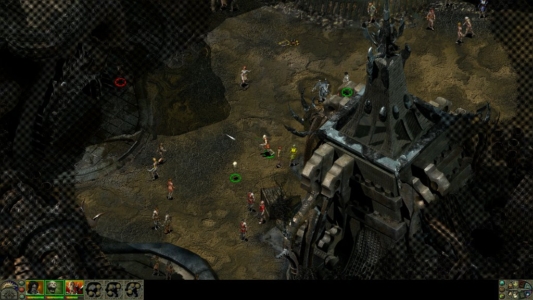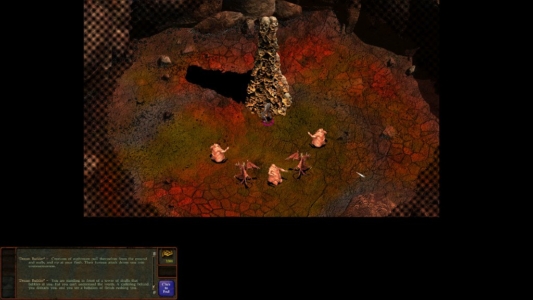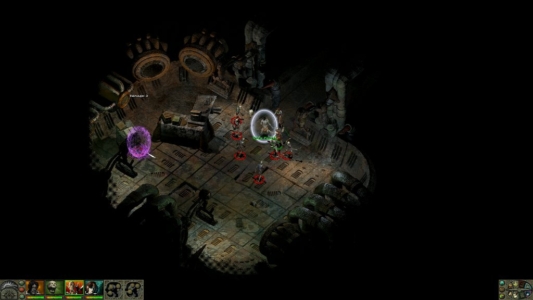
Planescape: Torment
Written by: Stoo
Date posted: April 11, 2011
- Genre: RPG
- Developed by: Black Isle Studio
- Published by: Interplay
- Year released: 1999
- Our score: 10
Yep, I’m pleased to report our RPG reviewing machine is grinding back into action. I thought it was high time I reviewed another, given that in all the years of the site I’ve only managed a dozen. To be more specific though I wanted to review something “worthy”, after the fun-but-ultimately-soulless Dungeon Siege. With that in mind, one of the old Infinity Engine games is always a good place to look for retro-minded RPG fans.
Just an overview in case they passed you by – we’re talking a small but well-regarded clutch of games, based on various flavours of Dungeons and Dragons, with the engine itself initially developed by Bioware. They’re mostly 2D-based with an isometric view, and give you control of a party of several adventurers, all in realtime but with the option to issue commands when paused. The run started with Baldur’s Gate which I reviewed a few years back, and I could have gone this time for its sequel Icewind Dale. Instead though, at the recommendation of many enthusiastic fans, I’ve opted for this one, kind of the beloved oddball of the group.
The term Planescape in the title refers to the setting, spread across multiple planes of existence. If you imagine the Prime Material plane as being the “real world”, that’s where all the elves and beards stuff takes place ie what we’d normally think of when someone says D&D. Around, above and below that however you have a whole load more planes. Some of these are based on the classical elements. Others are more philosophical in setup, manifestations of order and chaos, good and bad, and neutrality, all corresponding to D&D’s system of personality alignment. There are fiery hells, gray wastes, paradises and worlds of clockwork. All a bit trippy, but certainly something a bit different.
Within this, you take on the role of a man known only as the Nameless One. The initial setup has some standard D&D stat-choosing (hint: take wisdom) but there’s no faffing around with character classes until a while later. Instead you get your rude introduction to the Planes, which is: waking up on a slab in a mortuary. I should point out that the protagonist is not some kind of undead, despite his greyish complexion as seen on the box. He’s just… apparently recovered from being dead. Unfortunately though he also has no idea where he is or how he got there. The only friendly face to this bleak start is of all things, a cheerful floating skull called Morte who refers to him as “chief”. Morte seems keen to help and can at least give some instructions on what to do next. Because someone tattooed them on the Nameless One’s own back.
From here you pass into Sigil, which is essentially the central point of all those various planes. Ruled over by the mysterious all-powerful entity known as the Lady of Pain, It’s a city of portals, where all kinds of demons, wanderers, warriors and outcasts have washed up like flotsam. It has areas of grand riches, and terrible slums where the lowest elements of society scavenge for bodies to sell to death-obsessed cultists. Given that it’s floating amidst the sort of dimensions that are based on thought and emotion, it’s also the sort of place where maybe stuff will happen simply if you believe hard enough.
Let’s stop for a moment tho and talk about the aesthetics. The infinity engine was perhaps one of the last hurrahs for 2D graphics in mainstream gaming, and here it is highly effective. Sigil is wonderfully rich in detail, from the trash of the slums to the ornate and plush rich districts. This helps it come to life, a place you want to poke around and explore. Character sprites are also large and well animated, with little touches like slinging a weapon over their shoulder. The downside of that is you’ve only ever got a small area on screen at once. However these days there are mods that will bump everything up to high rez, effectively zooming out your view in the process, if you desire.
So anyway, once you’ve gotten your bearings, as you might expect it’s time to go exploring. You’ll pick up quests that progress the main story along, the Nameless One’s journey to find some answers. Maybe starting with finding whoever put him in the mortuary in the first place. You can also find a whole bunch of side-quests that give you a chance to find cash or experience or just learn more about the city of Sigil. You’ll pick up a few more companions too, absolutely none of whom are elves or dwarves. There’s a chaste succubus, and a semi-demon girl thief. Also a mechanical entity of pure order, who’s gone and gotten a bit disordered.
You’ll probably also be ready to go bash some monsters. After all that’s what we do in RPGs, right? Start fighting lowly rats, until we’ve built our guys up to more impressive feats. Well, there certainly is some of that in this game. If you’ve played anything D&D before you’ll be on familiar ground, and if not it’s not too hard to pick up. Mages can have a set of spells prepared and ready to fire off, needing a night’s rest to recharge. Thieves can turn invisible and do surprise attacks with a huge damage bonus. Oh and Morte is a surprisingly durable warrior, good for taking the brunt of an attack. If it goes wrong and you “die”, don’t worry, you get better.
However, there’s less emphasis on combat here than you might expect, and certainly not much of it is compulsory. It’s best to consider it a secondary feature; if hardcore D&D battling what you really want, maybe try Icewind Dale (which I hear is very respected amongst dungeon crawlers). Instead, the main focus of Torment, and aspect of the game that really makes it worthwhile, is the story. Sure, it might not seem to get off to a particularly original start with the “amnesiac protagonist” concept. Still, the telling of the tale is highly compelling.
The Nameless One is effectively immortal; death is only every a temporary state of affairs and he always comes back with new scars. So he wants to know how he ended up that way. As you progress through the game’s various objectives, tracking down clues and key figures from his past, you slowly learn new pieces of the puzzle. Bit by bit you’ll find out what he was trying to accomplish and what happened before his latest death. It’s often not a particularly happy tale, in fact there’s a lot of sadness and regret in there. Which might be a spoiler but then there is a clue in the title.
Meanwhile the characters you meet are troubled souls in their own way. This includes your party members, who don’t just sign up for a quest and then serve out the game as extra muscle for fights. Each has their own story, and in some cases it’s entwined with that of the Nameless one, illuminating some chapter of his past lives. Again it can paint a bleak picture, when you learn the nature of their relationships. Learning the story of his former lover is especially painful. They won’t tell you everything up front though, they might not even know the whole truth, so these stands have to be figured out, a stage at time.
That’s all learning what sort of a man the Nameless one was. However, it’s up to you to decide what he’s like today. While the overall structure of the plot is fairly linear, you determine the details of this latest chapter in his existence. You can be a callous jerk to the companions and a cruel lying bastard to the world around you. Or you can be kind and supportive, which I did, because I’m a sap and can’t bring myself to play bad guys. So you can be anywhere from lawful good to chaotic evil, according to the traditional D&D system.
Note that the mechanism by which most of this all happens is masses of dialogue – lengthy, branching conversations with multiple possible outcomes. This is, more than anything else, how the story movies forward. It can also be where a whole load of experience points lie, as you resolve quest objectives. So I hope you don’t mind stacks of text. It pays to read carefully and choose your words wisely (or maybe unwisely, if you’re playing a chaotic sort).
You’ll have plenty of options in a conversation, more if you have higher intelligence or charisma stats. You might also get the option to bluff or outright lie (and that will, along with whether you’re being nice or jerk, play its part in shaping your character alignment). What’s more, getting back to combat, most interactions that could lead to a confrontation also have a non-violent way out. If you’re clever, you can even debate your way out of the final “boss fight”, a fact which I think sums up Torment’s approach very neatly.
So then with such an emphasis on the antagonist’s personal journey and his nature (or natures plural, regarding past lives), here’s an RPG where you’re actually, er, playing a role. One of a man who isn’t out to save the universe or rescue a magic kingdom. Just learn the often-painful truth of who he was. You can engage with the story and characters on an emotional level that I’ve rarely seen in gaming. By the end I was genuinely attached to this band of misfits and found myself wishing they could find some happiness. The phrase “what can change the nature of a man” comes up often, and I genuinely wanted the Nameless One to find redemption.
I’m probably making this all out to be heavy going and, well it often is. However the game does keep a quirky nature about itself; after all the setting is a grim one but also rather surreal. So there are sidequests involving trying to plant trees in the city to make it a little more pleasant, or make conversation with zombies. There’s also a society of people sharing magically stored experiences and sensations (could any of these help jog the Nameless One’s memory?) and a brothel dedicated solely to intellectual pursuits, for men starved of conversation. Or you might just meet colourful travellers in a bar, and listen to tall tales of travelling the planes.
The game has a sense of humour too, and seems aware of RPG cliches, playing with our expectations a bit. We’ve already covered its somewhat ambivalent approach to dwelling too long on monster-bashing. Also there’s no armour, and only about 2 swords in the entire game. But the Nameless One can use his own arm as a club (hey, he grew another easily enough), and Morte gets special chattering attack teeth. Best of all, keep an eye out for the Mordron Maze, a knowing tribute to the square, repetitive dungeons of yesteryear.
Anyway just to make this look like a mobygames review I’ll end with a few criticisms, just to show I didn’t lose my critic’s hat completely. For all the talk of planes here, you won’t see much of them as you’re sat in Sigil for most of the game. What’s more when you do go outside, to a couple different kinds of evil plane – the game pretty much dumps you in a valley full of monsters, which jars with the style and pacing seen elsewhere. Fortunately if you get fed up, those parts are brief and you can just run for it.
So then Torment is one of those games that makes doing a site like this worthwhile. It’s over ten years old yet still highly recommended to anyone who wants an engaging and character-driven fantasy story. Hell even if you don’t like RPGs, as we’ve established it’s pretty different anyway. Baldur’s gate I found worthy but a little ordinary, like it was ticking every “good RPG” box without ever somehow being special. This one however had me gripped, the same way a good novel should. So if you’ve got a few bucks spare (and, okay, several dozen hours) then definitely have a look.





 Posts
Posts
I agree completely. Not just one of the best RPGs or best PC games of all time, but simply one of the best games of all time!
I had already played Baldur’s Gate at the time and was a big fan, but I didn’t know much about the Planescape Torment setting. I remember being put off at first because it was so different to what I was expecting (being written more like an adventure than a traditional RPG), but once I got into it, I couldn’t put it down and it remains as one of my all time favourites!
November 29, 2018 @ 2:32 pm